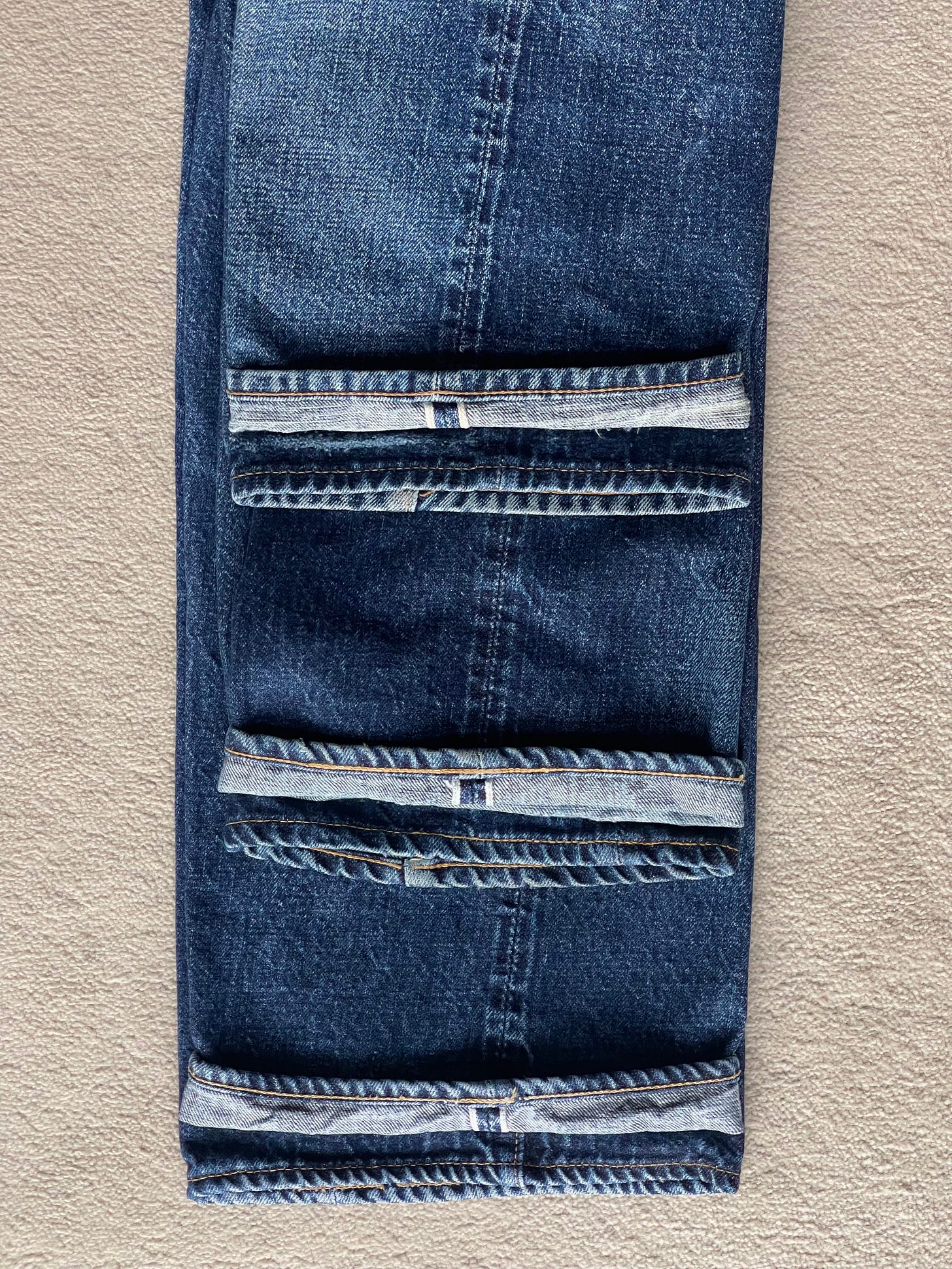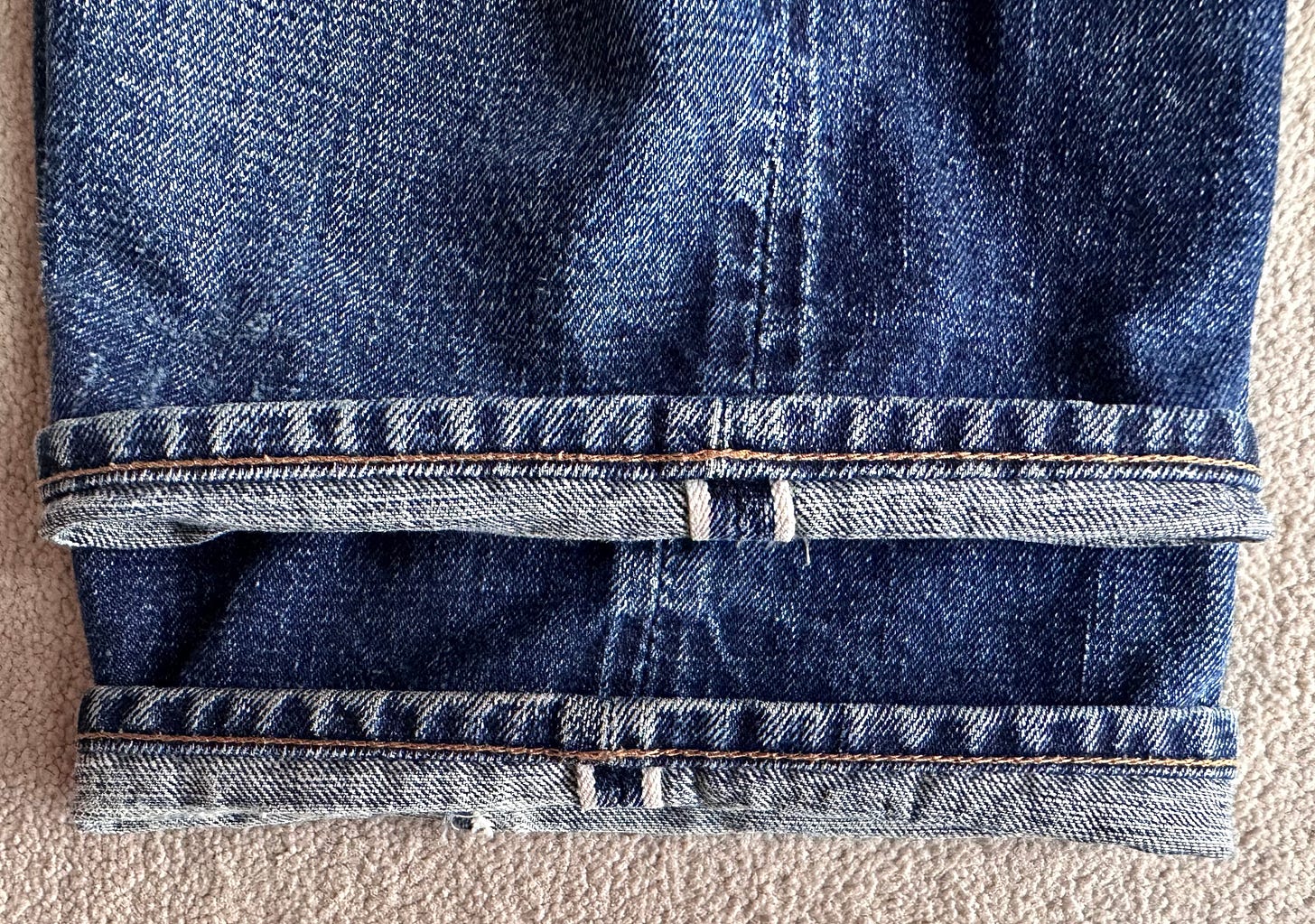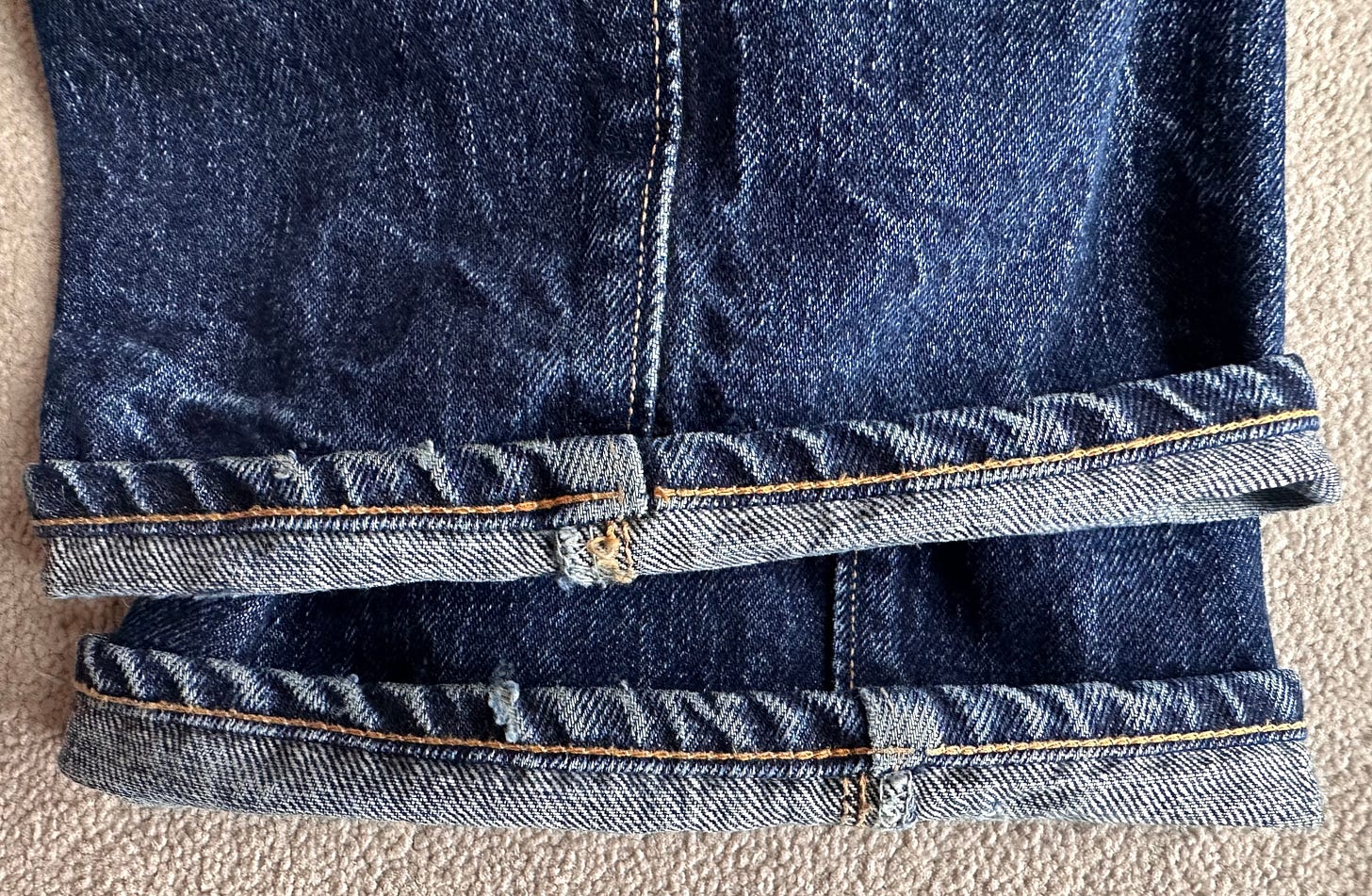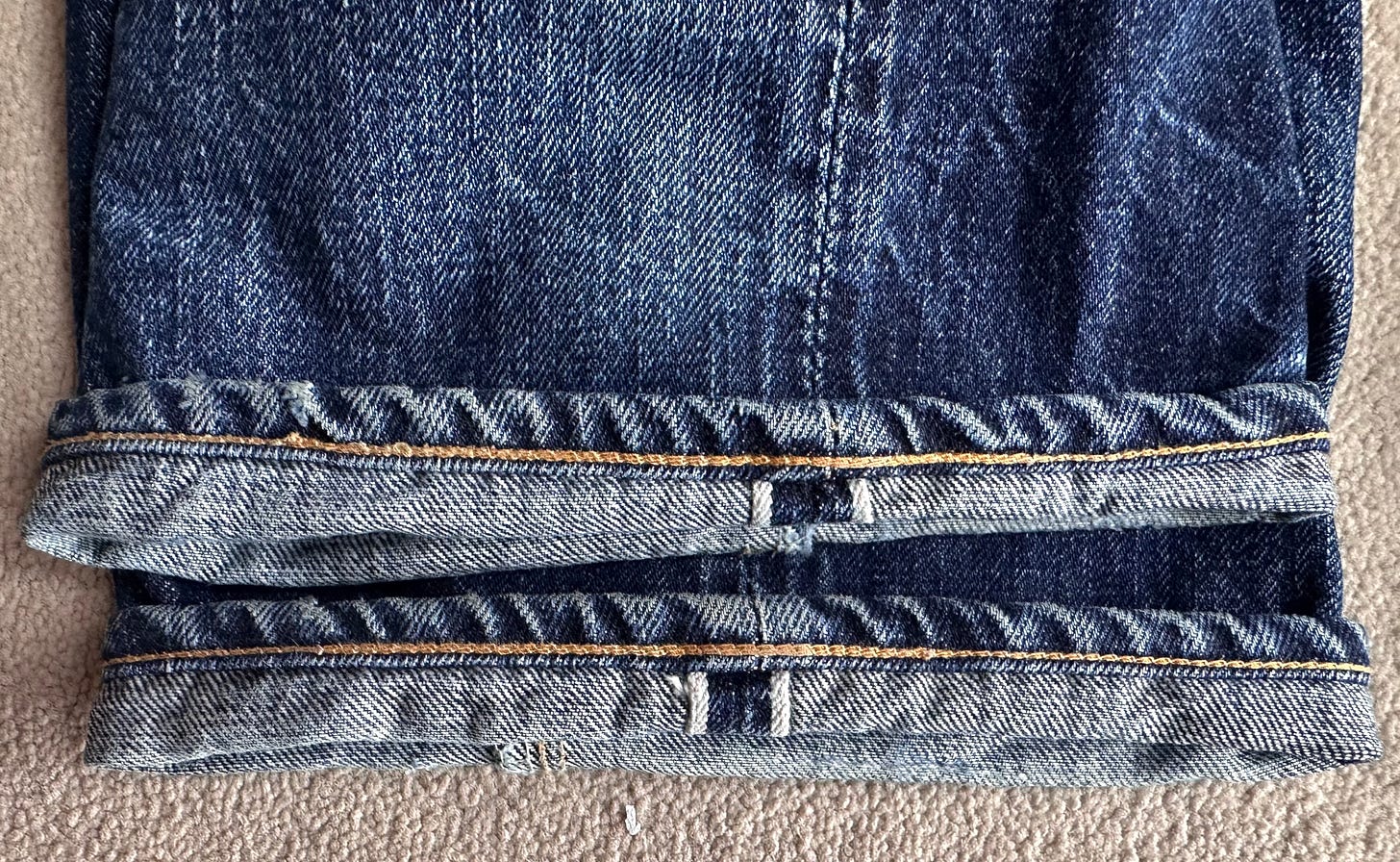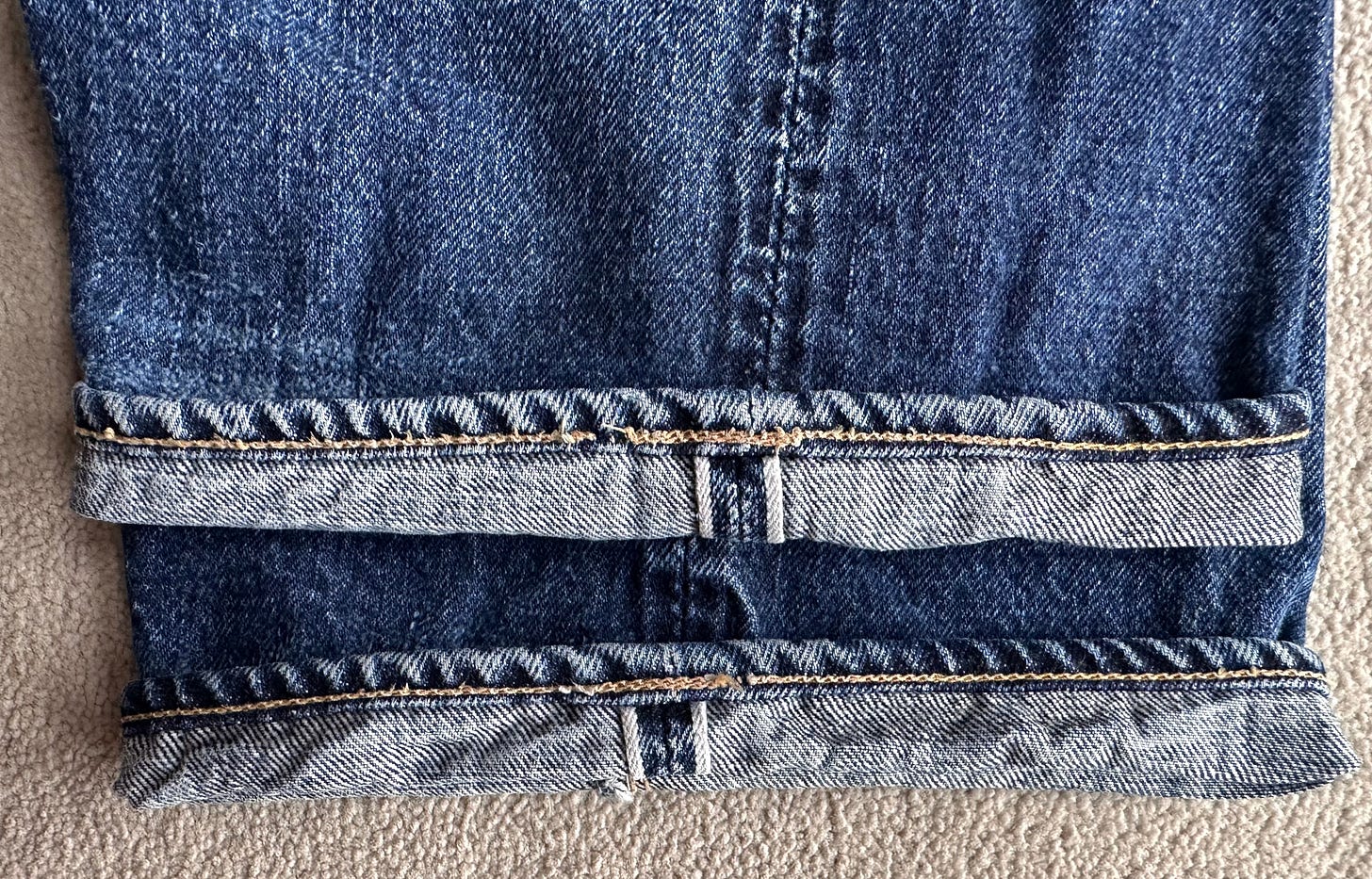The Subtle Art of Roping
For the love of raw denim.
Previously, I wrote about both the functional drawbacks of quality jeans and things I love about raw denim. Now, it’s time to take a step further and dive deep into one of the most sought-after details by denim enthusiasts — roping.
Roping is a fade pattern that appears at the leg opening due to the slight tension created in the bent fabric during hemming. Because of this tension, the bent fabric puckers, forming a sort of wave running through it. The raised part of the wave experiences more abrasion and thus fades faster. The lower part of the wave, on the contrary, retains a dark indigo shade longer. The contrast between the two forms a three-dimensional visual effect along the hem.
The shape of the wave highly depends on hemming. Some puckering appears to be vertical or parallel to the inseam. Others are twisted just enough to resemble the coveted rope found on American-made Levi’s 501s from the 1940s to 1970s. Denim enthusiasts still debate about what exactly causes the twisting. A common belief is that originally, it was triggered by the innate flaw in the Union Special 43200G hemming machine used by the major American brands, including Levi’s in the mid-20th century. Others argue that such twisting might be achieved by any sewing machine as long as you misalign the seams on the outside and underside of the hem.
Niche brands often talk about how quality clothing gets better with age. It is a beautiful story to sell, but hey rarely explain what it means though, let alone compare how different aspects affect the aging process.
I’ve been lucky to wear three pairs of exactly the same jeans made from exactly the same fabric — TCB 50s Regular jeans. One distinction between the three pairs is that they all have been hemmed differently. The first pair was hemmed by a local tailor on a modern machine. The second pair was hemmed by Arthur Leclercq, the founder of Superstitch. I kept the original hem on my third pair, meaning it was done at the TCB factory in Okayama, Japan.
In this article, I compare the difference in fading of the hem on three pairs of identical denim after more than 250 wears.
Before writing this article, I surveyed people on Instagram which of the three roping fades above they liked the most. I’m not sure all the respondents know what is roping, but 43% chose the pair in the middle; 32% selected the top pair; and 21% voted for the bottom pair. 4% opted for the “What roping?“ option.
I also reached out to Arthur from Superstitch and Hajime and Ryo from TCB and they all were able to recognize their work from the photo above. Which is fascinating if you ask me. Can you guess which one is which?
Small ask: If you find this article exciting, helpful, or crazy, please share it with your friends so we can get more people excited about denim. Also, leave a comment on the blog, or simply hit a ❤️ — means a lot to me. Thank you!
Modern Machine Hemming
My first two pairs of TCB 50s Regular jeans came unwashed with a 96 cm inseam. Even for me, at 190 cm tall, that’s too long. So I brought my first pair to a local atelier where they were actually aware of raw denim and claimed they set up their modern hemming machine to achieve proper roping.
The stitch itself is a decent chain stitch. When looking up close, I almost can’t tell the difference. The thread they picked faded similarly to the original one, although it is a couple of tones darker.
The fading pattern of the hem, that’s where the difference comes. While the puckering is there, as you can see the contrast, the pattern is far from the shape of a rope. The faded lines are mostly vertical and very blurred. The hem also feels almost flat to the touch and as a result, there are no blowouts in the fabric.
Remember I told you that denim enthusiasts still argue about what causes proper roping? According to one version, the coveted fade can be achieved by misalignment of seams at the face and undersides of the hem. Well, my three pairs of the same jeans all have slightly misaligned seams. But the resulting fades are still different. And the one that came from a modern machine hemming is the furthest from roping.
Union Special 43200G Hemming by Superstich
Years before launching his line of denim products, Arthur Leclercq started with a humble hemming service done with an original Union Special 43200G hemming machine he refurbished himself. Back in 2019, I was fortunate enough to visit him in his basement corner under the Holiday store in Paris. I was wearing my first pair of TCB 50s Regular jeans and brought my second, then new, pair for hemming.
The hems faded in a drastically different way to the ones done on a modern machine. You can see the twist in the raised parts of the wave, which, although not uniform, does resemble a rope. The puckering in the hem is three-dimensional to the touch and thus blew out in multiple places. This is the kind of hems found on the original vintage pairs of Levi’s 501s from the mid-20th century.
Union Special 43200G Hemming by TCB
My third pair of TCB 50s Regular jeans came one-washed with a shorter, 90 cm inseam. I also learned from experience that jeans keep shrinking even after multiple washes. So, decided to keep the original length. And the original chain stitched hem so that years later I could do this comparison.
TCB’s founder Hajime Inoue got into denim in junior high school. He then went on to sell jeans at a store in Kyoto only to realize he actually wanted to make them. He went to Okayama in search of a sewing job at one of the jeans factories. But with no prior experience, the only job he could get was in repairing vintage sewing machines. That’s how Hajime learned about the Union Special 43200G that his brand uses for hemming up to this day.
Again, the same pair of jeans, same fabric, even the same hemming machine. Yet, different fading pattern. The twisted waves are more frequent and pronounced than on a pair hemmed by Superstitch. Perhaps the reason is that the hems are a few millimeters shorter. And while the puckering is three-dimensional, too, the fabric hasn’t blown out yet. Although, I can clearly see it’s coming soon.
Conclusion
There is no right or wrong in the aging of quality clothes as long as it’s natural. But there are numerous details worth appreciating. One wouldn’t be able to recognize each of them separately, but together they make all the difference.
If you have any questions or feel like something is missing or just want to say this is crazy, please don't hesitate to jump to the comments section of this article. Let’s trip out together.
Also, I would greatly appreciate it if you could share the article with your friends and those who might dig it. Hitting a ❤️ and restacking it on Substack would motivate me a lot, too.
And if you would like further reading, here is a selection of some of my favorite articles:



